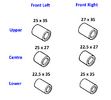
Thank you all - very much.
The 1999 version that
@Uncle Phil provided - I'd not even thought of looking at that because the fiches group the 1100AT / AV / AW together - implying that the 1996-1998 models are different from the 1999 and later models. The caliper itself has a different code number - ending G42, not G41 - I always thought that the last digit was a minor modification - but I've been checking those pistons. There are differences there too. The page provided by
@dwalby helped me to realise that the two were not the same. Almost the same size pistons - but their locations seem to be different.
But the Ron Ayers site is useful - the caption for the 1997 model seals helps to understand the annotation. The Ron Ayers site has the pairs of numbers on the diagram for the left hand caliper, but the numbers for the right hand caliper for the pistons and seals are shown in brackets.
@Uncle Phil had spotted those too. See image right. My diagram was missing those brackets. I assumed top number was right hand caliper, bottom was left. Which was wrong, but also the position top/bottom is not consistent.
All of the numbers are shown on the diagram for the left hand caliper. So the
number in brackets are for the right hand caliper. The seals numbering make this bracket annotation essential. The left hand caliper has seals (not in brackets) 2, 2 and 3. The right hand caliper (numbers in brackets) has seals 3, 1 and 2.
The caption in the RonAyers Fiche reveals this. Eg for part number 2 is says : Seal Set, Piston, Right Side Qty 1 & Left side Qty 2.
The numbers on the fiche that I showed in my first post has none of these clues - it just shows the numbers without the numbers in brackets and the part list at the side has no explanation. It is impossible to be sure.
I thought it was worth writing this up with all of the pointers that people have provided. It didn't give me the answer, but it certainly helped me to find the answer. Almost.
It still doesn't help determine the order.
It looks as though the 10 (15) piston should be in the top bore from the diagram - but I am not sure that this is correct. I am inclined to think that the top piston in the diagram is the centre piston in the caliper - that is because normally the shorter piston is in the centre bore - to allow room for the drilled sluice that passes behind to connect the two outer bores. The measurements for the pistons eg 22x27 means 22mm diameter, 27mm long. 27 mm is definitely the shorter one.
When I find out, I'll come back and correct this.
All of this is research. My brother has an 1100AV. He has little mechanical knowledge and his brakes have started dragging a little. He has recently had new tyres fitted at a dealers and I am hoping that is the clue. He lives 2 hours away.
The original plan was when it needed servicing, we'd ride to meet up halfway and swap bikes. We are both named riders on each others insurance. But dragging brakes has put the mockers on that plan, it is not advisable to ride it. So I need to get there with tools and the parts that will definitely need to be replaced and make it rideable again. Anything extra that is needed get it ordered quickly, then go back when the bits arrive.
Thanks folks.






